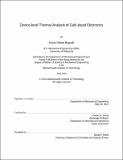Device-level thermal analysis of GaN-based electronics
Author(s)
Bagnall, Kevin Robert
DownloadFull printable version (5.507Mb)
Alternative title
Device-level thermal analysis of Gallium nitride-based electronics
Other Contributors
Massachusetts Institute of Technology. Department of Mechanical Engineering.
Advisor
Evelyn N. Wang.
Terms of use
Metadata
Show full item recordAbstract
Gallium nitride (GaN)-based microelectronics are one of the most exciting semiconductor technologies for high power density and high frequency electronics. The excellent electrical properties of GaN and its related alloys (high critical electric field, carrier concentration, and carrier mobility) have enabled record-breaking performance of GaN-based high electron mobility transistors (HEMTs) for radio-frequency (RF) applications. However, the very high power density in the active region of GaN HEMTs leads to significant degradation in performance as the device temperature increases. Thus, effective thermal management of GaN-based electronics is a key to enabling the technology to reach its full potential. Despite the vast amount of research into thermal issues in GaN-based electronics, including both modeling and experimental studies, there are a number of poorly understood issues. For instance, the heat source distribution in GaN HEMTs for RF applications has not been quantified nor have metrics been published for the heat flux in the near-junction region. Often, device engineers neglect the importance of thermal boundary conditions, which play a major role in shaping the temperature distribution in the device. Temperature rise in GaN HEMTs is typically modeled using computationally expensive numerical methods; analytical methods that are more computationally efficient are often quite limited. In this thesis, a literature review is given that discusses previous research in thermal issues in GaN-based electronics and that provides a perspective on the important factors to consider for thermal management. Electro-thermal modeling tools validated with test devices were used to derive quantitative information about the heat source distribution in GaN HEMTs. Both numerical and analytical thermal models were developed that provide helpful insight into the dominant factors in the formation of highly localized hotspots in the near-junction region. The Kirchhoff transformation, a technique for solving the heat conduction equation for situations in which the thermal conductivity of a material depends on temperature, was extended and applied to GaN HEMTs. The research described in this thesis provides critical information in understanding thermal issues in GaN-based electronics required to develop next generation near-junction thermal management technologies.
Description
Thesis (S.M.)--Massachusetts Institute of Technology, Dept. of Mechanical Engineering, 2013. This electronic version was submitted by the student author. The certified thesis is available in the Institute Archives and Special Collections. Cataloged from student-submitted PDF version of thesis. Includes bibliographical references (p. 114-119).
Date issued
2013Department
Massachusetts Institute of Technology. Department of Mechanical EngineeringPublisher
Massachusetts Institute of Technology
Keywords
Mechanical Engineering.